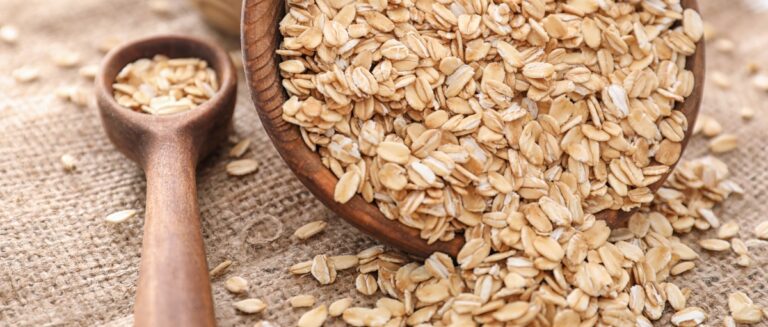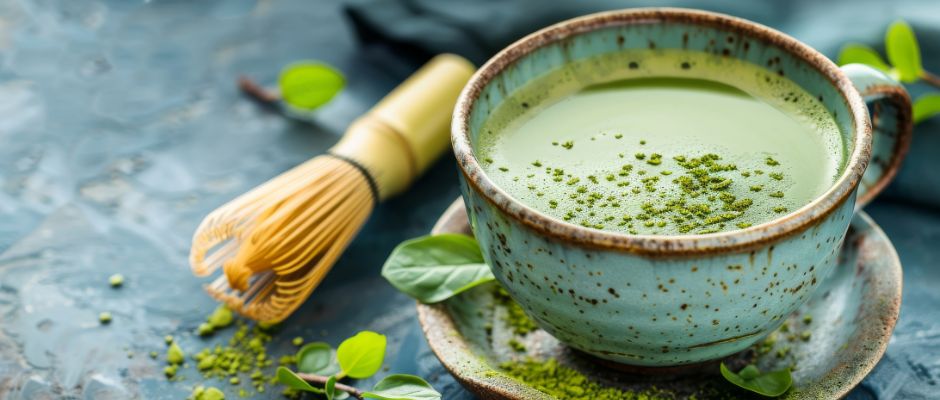Once an obscure ceremonial tea enjoyed by Buddhist monks and Japanese royalty, matcha has skyrocketed to superfood stardom in recent years. In the U.S. alone, the matcha tea market is expected to nearly double in the next 10 years.
And for good reason—this vibrant green powder packs a powerful punch of nutrition and health benefits.
So, what exactly is matcha, and what makes it so special? Unlike regular green tea, which steeps and discards the tea leaves, matcha grinds the entire leaf into a fine powder. This means you’re consuming a concentrated dose of green tea goodness.
Some studies have exaggerated its antioxidant properties. For example, you may have seen the figure that matcha tea has 137 times more antioxidants than low-grade green tea. This was true for one specific, low-grade green tea but not representative of the entire green tea line up.
However, studies clearly show that matcha tea is packed with antioxidants (just maybe not 100 times more than their traditional green tea counterpart).
But the benefits of matcha go far beyond just antioxidants. From boosting brain power to supporting heart health to enhancing weight loss, this ancient elixir has a lot to offer for modern wellness.
What is Matcha?
Matcha is a special type of green tea enjoyed in Japan for centuries, though it’s origins are actually traced back to China. It’s made from the leaves of the camellia sinensis plant, but it’s grown and processed differently than other green teas.
About 20-30 days before harvest, matcha plants are covered with shade cloths to trigger the growth of leaves with better flavor and texture. This shading also boosts the leaves’ chlorophyll levels, giving them a vibrant green color. Additionally, the shade increases the production of amino acids like L-theanine, which promotes relaxation and mental clarity.
After harvesting, the stems and veins are removed from the tea leaves. Then, the remaining leaf material is stone-ground into a fine, bright green powder. Because matcha is made from the entire leaf, it’s a more potent source of nutrients than regular green tea.
Matcha is richer in antioxidants than traditional green tea! These antioxidants, particularly catechins like EGCG, are believed to be responsible for many of matcha’s health benefits.
Traditionally, matcha is prepared by whisking the powder with hot water in a bowl to create a smooth, frothy beverage. But nowadays, matcha is also enjoyed in more contemporary ways – mixed into lattes, blended into smoothies, or even used as a unique flavor in baked goods and other recipes.
While matcha may have ancient origins, it’s incredibly versatile for the modern lifestyle. With its unparalleled nutrition profile, matcha offers a tasty way to boost your health. Let’s explore how this green powerhouse can benefit your mind and body.
Matcha’s Nutritional Profile
What is matcha good for? Its unique composition of nutrients and beneficial plant compounds.
Matcha is rich in polyphenol antioxidants, especially a type of catechin called epigallocatechin gallate (EGCG). EGCG has been widely studied for its potential to prevent chronic diseases like heart disease and cancer. Matcha contains about 3 times more EGCG than regular green tea!
Another key component of matcha is L-theanine, an amino acid that promotes relaxation and mental clarity by increasing alpha waves in the brain. L-theanine also helps counteract the jittery effects of caffeine, giving matcha a “smoothe energy” compared to coffee.
Speaking of caffeine, matcha contains about 35mg per half-teaspoon serving – more than regular green tea but less than coffee. The combination of caffeine and L-theanine is thought to produce an “alert calm” perfect for focused tasks.
Matcha is also a good source of vitamin C, selenium, chromium, zinc, and magnesium. It even contains fiber, thanks to being made from the whole leaf. All these nutrients work together to give matcha its impressive health benefits.
6 Health Benefits of Matcha
1. Boosts Brain Function
The combination of caffeine and L-theanine in matcha is like a match made in heaven for your brain. A landmark 2010 study found that this duo significantly improved attention and processing speed without the usual caffeine crash.
New studies suggest that matcha may also protect against age-related cognitive decline. The potent antioxidants in matcha help fight oxidative stress and inflammation, major drivers of neurodegenerative diseases like Alzheimer’s and Parkinson’s. Animal studies suggest that matcha may even help improve memory and learning ability.
2. Supports Heart Health
Green tea has long been associated with heart health, and matcha may be even more beneficial due to its higher antioxidant content. EGCG and other catechins help reduce “bad” LDL cholesterol and triglycerides while raising “good” HDL cholesterol.
Matcha’s anti-inflammatory properties also help protect delicate blood vessels from damage and calcification. A 2014 meta-analysis concluded that green tea significantly reduces systolic blood pressure, a major risk factor for heart disease and stroke.
3. Enhances Weight Loss
Looking to slim down? Matcha may be your new best friend. The caffeine and EGCG in matcha have been shown to boost metabolism and increase fat burning, especially during exercise.
One study found that men who drank matcha before cycling burned 17% more fat than those who didn’t. Matcha may also help reduce body fat and waist circumference, even without major lifestyle changes.
Of course, matcha is no magic bullet for weight loss. But combined with a balanced diet and regular movement, it can be a tasty tool for reaching your goals.
4. Strengthens Immune System
Our immune systems can always use a helping hand, and matcha is happy to oblige. The high concentration of antioxidants in matcha helps neutralize harmful free radicals and reduce oxidative stress, a major contributor to weakened immunity.
Matcha also has potent antibacterial and antiviral properties. One study found that EGCG can bind to cells in the outer membrane of influenza viruses and stop them from infecting other cells. Talk about flu-fighting power!
Some research suggests that matcha’s unique compounds may help balance the immune system and reduce the risk of autoimmune disorders. More studies are needed, but it’s a promising area of research.
5. Anti-Aging and Skin Benefits
Antioxidants are the not-so-secret weapon against premature aging, and matcha is loaded with them. The catechins in matcha help protect the skin from UV damage, a major cause of photoaging and wrinkles.
Matcha also helps preserve collagen, the protein that keeps skin firm and elastic. A recent study found that regular green tea consumption was associated with 25% less sun damage and significantly better skin elasticity.
When applied topically, matcha can help soothe inflammation, reduce redness, and even improve acne. EGCG’s antibacterial properties help fight acne-causing bacteria, while its anti-inflammatory effects calm angry breakouts.
6. Potential Cancer Prevention
One of the most exciting research areas on matcha is its potential to prevent cancer. Preliminary research suggests an inverse link between matcha tea consumption and cancer cell growth.
The EGCG in matcha has been found to inhibit tumor growth and metastasis in several types of cancer, including breast, prostate, and colorectal. It works by inducing apoptosis (programmed cell death) in cancer cells and halting angiogenesis (forming new blood vessels to feed tumors).
Of course, cancer prevention is complex and multifaceted. But adding matcha to an overall healthy lifestyle may be a smart strategy for reducing your risk.
Possible Drawbacks and Side Effects
For all its benefits, matcha isn’t right for everyone. The most obvious concern is the caffeine content. While less than coffee, matcha still contains enough caffeine to cause side effects in sensitive individuals.
Too much caffeine can lead to jitteriness, anxiety, insomnia, digestive issues, and increased heart rate. It can also interact with certain medications. If you’re pregnant or have a pre-existing health condition, talk to your doctor before adding matcha to your routine.
Matcha also contains fluoride, a mineral that can be beneficial for dental health but harmful in large doses. Excessive fluoride intake over time can lead to skeletal fluorosis, a painful condition of joint damage and brittle bones. However, this is rare and usually only occurs with extremely high consumption of low-quality teas.
To minimize your risk, choose high-quality matcha from reputable sources. Cheap, low-grade matcha is more likely to be contaminated with lead and other toxins from soil and processing. A good rule of thumb is to look for vibrant green matcha that isn’t too cheap – you get what you pay for!
How to Incorporate Matcha into Your Diet
Ready to try matcha? There are countless ways to enjoy this verdant powder and reap its many benefits.
The traditional way to drink matcha is whisked with hot water in a bowl until frothy. Use a bamboo matcha whisk for best results, and sift the powder first to avoid clumps. Start with 1/2-1 teaspoon of matcha per cup of water, and adjust to your taste.
For a more modern take, try a matcha latte. Just mix matcha with steamed milk of your choice and sweeten to taste with honey or your favorite sweetener. Iced matcha lattes are also delicious and refreshing.
Matcha is also fantastic in smoothies. Just add 1/2-1 teaspoon to your favorite smoothie recipe for an antioxidant boost. Matcha pairs especially well with banana, vanilla, and nut milks.
You can even cook and bake with matcha! Try adding it to oatmeal, yogurt bowls, energy balls, or baked goods like muffins and cakes. The possibilities are endless.
Aim for 1-2 teaspoons of high-quality matcha per day for optimal health benefits. Listen to your body and find the sweet spot that gives you energy and clarity without the jitters.
When selecting matcha, look for a bright green color, smooth texture, and slightly sweet, grassy aroma. Avoid matcha that looks dull or brownish, as this indicates lower quality and/or age. Japanese matcha is generally considered the gold standard.
Go for the Green!
As we’ve seen, matcha is much more than just a trendy beverage. This powdered green tea is a true superfood with a unique nutritional profile and many science-backed matcha benefits for the mind and body.
Matcha seems to do everything from boosting brain power and burning fat to strengthening immunity and fighting aging. Its power lies in its concentrated antioxidants, catechins like EGCG, amino acids like L-theanine, and of course, a gentle caffeine kick.
While not without potential side effects, matcha is generally safe and beneficial when consumed in moderation and sourced from high-quality suppliers. With so many delicious ways to enjoy it, there’s never been a better time to go green with matcha.
Whether you’re a seasoned tea connoisseur or a curious wellness seeker, we encourage you to try matcha and experience its magic for yourself. Your body and mind will thank you!
Sources
Straits Research. (2024). Matcha tea market report: Industry trends, opportunities, and forecast 2024–2030. Straits Research. https://straitsresearch.com/report/matcha-tea-market
Yunomi Life. (2023). The myth of matcha and the claim it has 137x antioxidants of green tea. Yunomi Life. https://yunomi.life/blogs/japanese-tea-guide/114244037-the-myth-of-matcha-and-the-claim-it-has-137x-antioxidants-of-green-tea
Moustakas, K., & Tsatsakis, A. M. (2020). A comprehensive review of the health benefits of matcha tea: A nutraceutical approach. Toxicology Reports, 7, 1179-1189. https://www.ncbi.nlm.nih.gov/pmc/articles/PMC7231151/
Matcha Outlet. (2023). The origins and history of matcha. Matcha Outlet. https://matchaoutlet.com/pages/the-origins-and-history-of-matcha
Nutraceuticals World. (2024, May 21). L-theanine ingredient linked to stress relief, focus: Clinical study. Nutraceuticals World. https://www.nutraceuticalsworld.com/contents/view_breaking-news/2024-05-21/l-theanine-ingredient-linked-to-stress-relief-focus-clinical-study/
Bryan, J., et al. (2011). L-theanine, caffeine, and cognitive performance: A double-blind, placebo-controlled study. Nutritional Neuroscience, 14(4), 163-170. https://pubmed.ncbi.nlm.nih.gov/21040626/
Kimura, T., et al. (2020). The health benefits of tea polyphenols: A comprehensive review. Antioxidants, 9(12), 1280. https://www.ncbi.nlm.nih.gov/pmc/articles/PMC7760932/
Cai, Y. Z., et al. (2014). Phenolic compounds in matcha tea and their effects on human health: A review. Molecules, 19(11), 18321-18342. https://www.ncbi.nlm.nih.gov/pmc/articles/PMC4150247/
Bryan, J., et al. (2008). The effects of tea consumption on cognition and mood: A systematic review. Nutritional Neuroscience, 11(4), 193-210. https://pubmed.ncbi.nlm.nih.gov/18326618/
Zhao, D., et al. (2020). Matcha green tea enhances fat oxidation during moderate-intensity exercise in young women. Journal of the International Society of Sports Nutrition, 17(1), 34. https://www.ncbi.nlm.nih.gov/pmc/articles/PMC7796401/
Unno, K., et al. (2022). Matcha tea consumption and psychological stress reduction: A randomized placebo-controlled trial. Nutrients, 14(15), 3149. https://www.mdpi.com/2072-6643/14/15/3149
Unno, K., et al. (2018). Green tea consumption and stress reduction: Evidence from animal and human studies. Molecules, 23(9), 2075. https://www.ncbi.nlm.nih.gov/pmc/articles/PMC6128439/











